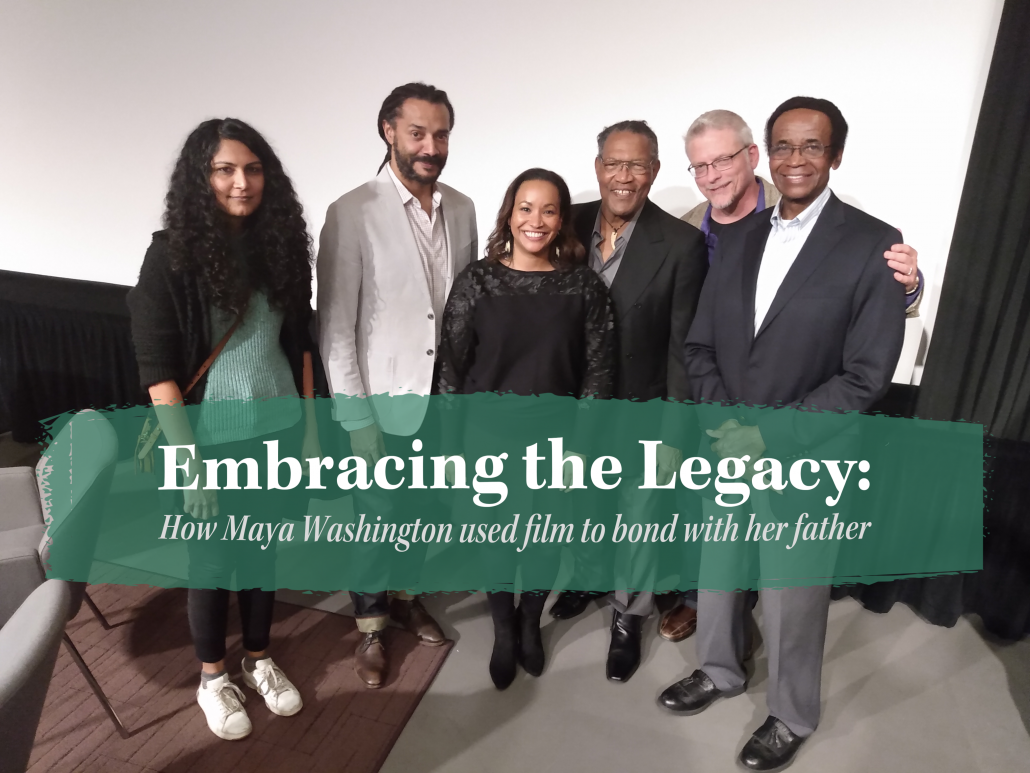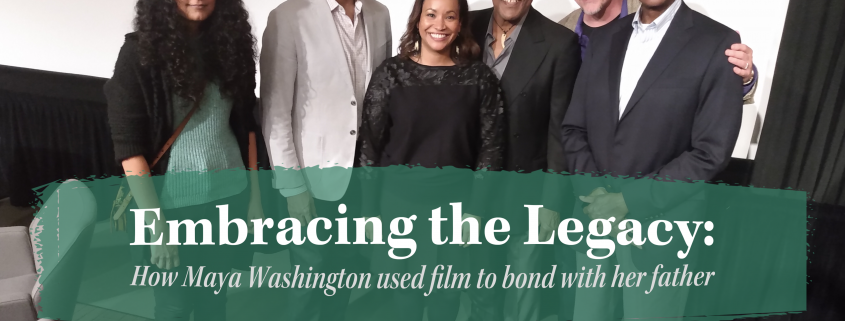Embracing the legacy: How Maya Washington used film to bond with her father

Most people go to college looking to make a name for themselves. Maya Washington just wanted to be a number.
Washington always felt singled out as a kid. Growing up in Plymouth and Wayzata, Minn., she was one of the few Black students in her schools. This lack of diversity was evident in her yearbooks, which went entire pages without displaying a photo of a person of color.
However, she was singled out even more as the youngest daughter of Gene Washington, a former wide receiver for the Minnesota Vikings and a Michigan State legend. To fit into a community where she wouldn’t always be the focus of attention, she decided to go to USC, a bigger and more diverse population where no one would know what her father accomplished.
It wasn’t until after she graduated with a bachelor’s in dramatic arts that Maya realized she really wanted to learn more about her father’s past. At a 2011 memorial for Bubba Smith, one of her father’s teammates at Michigan State, Maya met many of Gene’s friends, all of whom told her stories that got her creative mind spinning.
USC Visions and Voices screened Maya’s film “Through the Banks of the Red Cedar” Feb. 6 at the auditorium in Wallis Annenberg Hall. The film, which premiered at the 2018 Detroit Free Press Film Festival, follows Maya’s discovery of her father’s history as a pioneer football player, a wide receiver out of Texas who was recruited to Michigan State because Southern teams did not recruit Black players.
Then-Spartans head coach Duffy Daugherty sought a competitive advantage by recruiting in the untapped African American communities south of the Mason- Dixon Line, and it paid off. Michigan State won back-to-back national championships in 1965 and 1966, making a nationwide statement about the value of recruiting Black players.
“We didn’t know what we were doing,” said Clinton Jones, a Spartans running back who entered the program with Gene and soon became his close friend. “We chained together as young men, 17 or 18 years old, who played football at Michigan State, and all we wanted to do was play football … We had no idea that we would create, through our victories, a momentum, and a joy and a happiness that permeated the campus and the United States, especially for people of color.”
For his role on those championship teams, Gene was inducted into the College Football Hall of Fame in 2011. He also won the 1969 NFL Championship with the Minnesota Vikings.
Maya was born shortly after her father’s career concluded in 1974, and because he didn’t push his children to take part in sports or talk much about his playing days, she didn’t think too much about his role in history. Through making the film, she discovered a lot about what her father accomplished, and they’re both thankful the process brought them closer together.
“For most of us, we know our parents in terms of whatever profession or work they did when they left the house and came home at the end of the day, however many jobs they worked to provide for a family,” she said. “But to understand the significance of what historical things may or may not have taken place around those experiences, I think was a big eye-opener for me.”
Her father, known by family and friends as humble and soft-spoken, shared that sentiment.
“It really gave us an opportunity, especially for me to get to know her a lot better,” Gene said. “She was finding out all this information from family members and learning a lot about her dad. I found it very interesting and a pleasant surprise that really made me think.”
While making the film, Maya was surprised by the subjects’ accounts of their experiences with racism. She was expecting to hear of the heinous acts and righteous response typical of the Civil Rights era, but her father and his teammates said everyone got along at Michigan State for the most part.
Maya said this opened her eyes to the different frames through which she and her parents experienced racism. She remembers learning about the era her father grew up in, where people who looked like him lived every day with the threat of being embarrassed and rejected simple services such as eating in a restaurant or staying in a hotel.
“The way my dad saw it was ‘I get a meal plan where I have food, I have a place to sleep and I’m getting an education in exchange for my passion and ability to run track, play football and win championships,’” she said. “And so from their standpoint, if someone looked at them funny, or called them a name or did anything that by today’s standards would be considered inappropriate and grounds for some kind of action or clapback, in my dad’s day, you didn’t really have a place to go.”
Maya clearly had a different college experience than her father. There were more people who looked like her at USC, and she made sure to apply to live in Somerville Place, an African American student housing community, to foster that sense of belonging.
And yet, the sense of being othered didn’t stop at USC, which, while more diverse than the Minnesota areas she grew up in, was still a predominantly white school. Maya was one of the Black students in her theatre program who, along with Latinx and Asian American classmates, had to appeal to their dean and administrators to diversify their Eurocentric course material, which didn’t feature many minority creators.
As opposed to her father, who shrugged off even explicit racism, Maya recognized microaggressions that acted as a way for white students and faculty to express their ignorance. She recalled performing a monologue from “Sally’s Rape,” a Black feminist play by Robbie McCauley, which was an ambitious choice for the assignment. The response was less than supportive.
Her classmates stared at her with “a deer in the headlights look.” Some of them left the class because they didn’t have the maturity to handle the experience.
Still, Maya enjoyed her time at USC because she had the opportunity to pursue all the creative directions her heart desired. Since graduating, she has worked as a writer, director, performer and art educator with experience in areas from film and theater to public art and social activism.
After the February screening concluded, Maya was nearly mobbed by her many friends in attendance. Her smile only seemed to get wider as she greeted friends and family, and it never wavered when meeting the strangers that her friends brought along to the event.
Anisha Acharya, who became Maya’s editor midway through the filmmaking process, attributed Maya’s positive, energetic attitude to her performative background.
“We had all of these fun sequences and montages that we constructed basically inspired out of that energy that she has, because she was so excited,” Acharya said. “That definitely factored into the process of how we approached stylistically what she wanted the documentary to be like.”
Gene said he is proud of all Maya has accomplished, but the film is the work of hers that hits closest to home for him.
“When you’re trying to put a documentary together or tell a story, there’s a whole lot of qualities that you as a person have to have,” he said. “That patience, that discipline and determination, and working hard to get better and get it done. I’ve seen all of that, and I’m so, so proud that she has mastered that skill.”
Gene’s pride in Maya’s work speaks to not only how strong their relationship has always been, but also the unique role “Through the Banks of the Red Cedar” has had in bringing them closer together. Maya relished the chance to screen the film at USC. At the place she went to escape from Gene’s shadow, she and her father got to celebrate the thing that brought them closer together.
“It was really special to have made this screening of the film and coming full circle of embracing and loving my dad’s history, and loving him through that history and being able to share that openly on this campus,” Maya said.

